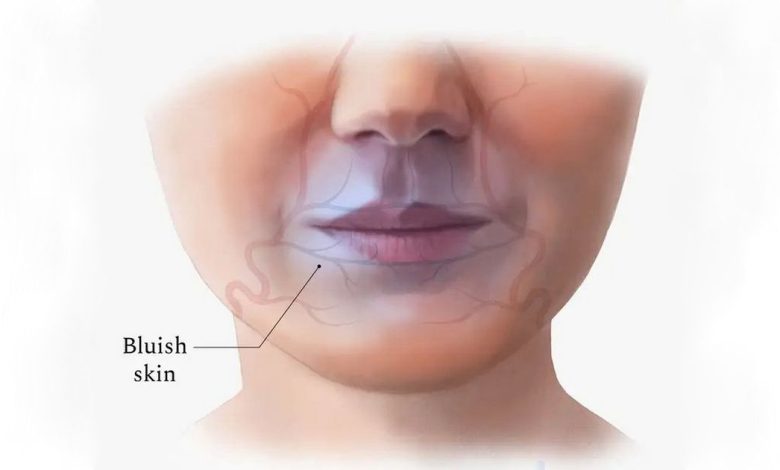Blue skin: what is this, causes, symptoms, diagnostics, treatment, prevention

Blue discoloration of the skin; Lips – bluish; Fingernails – bluish; Cyanosis; Bluish lips and fingernails; Bluish skin
What is blue skin
Blue skin is a condition, in which the skin acquires a bluish tint. It is caused by many factors and can range from mild to severe.. In some cases, blueing is limited to certain areas of the body or may affect the entire body..
Causes of blue skin
Blue skin can be caused by a number of factors., including:
- Low oxygen levels in the blood (cyanosis). it happens, when the level of oxygen in the blood is below normal, what can be caused by various conditions, including heart and lung disease.
- Some medications. Some medications, such as beta-blockers and antimalarials, can cause a bluish tint to the skin.
- Methemoglobinemia. This condition, in which red blood cells contain an abnormal form of hemoglobin, called methemoglobin. This can lead to, that the skin will take on a bluish tint.
- Exposure to certain chemicals or toxins. Exposure to certain chemicals or toxins can cause a bluish tint to the skin..
- Raynaud's phenomenon. Condition, in which low temperatures or strong emotions cause blood vessel spasms, that block blood flow to the fingers, Foot, ears and nose.
Blue skin symptoms
The main symptom of cyanotic skin discoloration is a bluish tint to the skin.. It may affect the whole body or part of it.. In some cases, discoloration may be accompanied by other symptoms., including:
- Fatigue
- Weakness
- Breathlessness
- Pale skin
- cold skin
- Numbness
- Pricking
- Swelling
When to contact a healthcare professional
If you are experiencing any of the symptoms, above, or if you notice blue skin, you should see a doctor. Your doctor will be able to determine the cause of the discoloration and recommend appropriate treatment..
Diagnosis of blue skin
Your doctor may perform a physical examination and ask about your medical history, to diagnose the cause of the blue color of the skin. In some cases, additional tests may be prescribed to diagnose the problem., such as blood tests, x-ray or electrocardiogram.
Blue skin treatment
Treatment for blue skin depends on the underlying cause.
- Low oxygen levels in the blood (cyanosis). The doctor may suggest supplemental oxygen, to improve oxygen levels.
- Some medications. Your doctor may recommend changing or adjusting your medications.
- Methemoglobinemia. The doctor may recommend medication, such as methylene blue, to treat this condition.
- Exposure to certain chemicals or toxins. The doctor may recommend medications or treatments to treat the condition.
- Raynaud's phenomenon. The doctor may recommend medication, such as calcium channel blockers or vasodilators, to treat this condition.
home treatment for blue skin
In some cases, blue skin can be treated at home..
- Low oxygen levels in the blood (cyanosis): avoiding strenuous activity and rest can help increase oxygen levels.
- Some medications: it is important to avoid drugs, which may cause discoloration.
- Methemoglobinemia: it is recommended to avoid foods and drinks, which can cause methemoglobinemia.
- Exposure to certain chemicals or toxins: it is important to avoid contact with the pathogen.
- Raynaud's phenomenon: wearing gloves to keep hands warm in cold temperatures can help relieve symptoms.
Prevention of bruised skin
In some cases, it is possible to prevent blue skin.
- Low oxygen levels in the blood (cyanosis): avoiding high altitudes or strenuous activity can help prevent this condition.
- Certain medications. Discuss any medications with your doctor, that you take, To make sure, that they do not cause color change.
- Methemoglobinemia: it is important to avoid foods and drinks, that can cause this condition.
- Exposure to certain chemicals or toxins. Wearing protective equipment, such as gloves and masks, when working with chemicals or toxins can help prevent this condition.
- Raynaud's phenomenon: keeping hands and feet warm in cold temperatures can help prevent this condition.
Used sources and literature
Fernández-Frackelton M. Cyanosis. In: Walls RM, Hockberger RS, Gausche-Hill M, eds. Rosen’s Emergency Medicine: Concepts and Clinical Practice. 9th ed. Philadelphia, PA: Elsevier; 2018:chap 11.
McGee S. Cyanosis. In: McGee S, ed. Evidence-Based Physical Diagnosis. 5th ed. Philadelphia, PA: Elsevier; 2022:chap 9.
